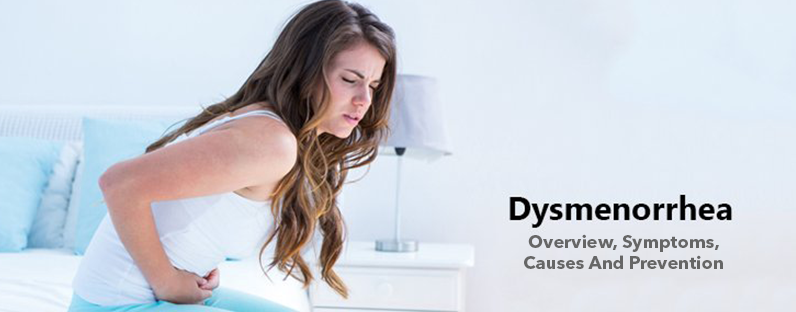Dysmenorrhea- Overview, Symptoms, Causes and Prevention
Overview
Dysmenorrhea (Menstrual cramps) are throbbing or cramping pains in the lower abdomen. Many women suffer from menstrual cramps just before and during menstrual periods.
For some women, the discomfort is merely annoying. For others, menstrual cramps may be serious enough to interfere with the daily activities every month for a few days.
Menstrual cramps can be caused by conditions such as endometriosis or uterine fibroids. Treating the cause is the key to diminishing pain. Menstrual cramps not caused by another disease tend to decrease with age, and sometimes improve after birth.
Symptoms
Chances are, you know all too well how it feels. You may have:
- Aching pain in your belly (sometimes severe)
- Feeling of pressure in your belly
- Hip pain, lower back pain and inner thighs
When cramps are severe, symptoms may include:
- Upset stomach, sometimes with vomiting
- Loose stools
When to call a doctor
If your ability to perform simple tasks each month interferes with menstrual discomfort, it might be time to speak to a gynaecologist.
Talk to your doctor about your symptoms and if you experience any of the following:
- Continuing pain after IUD placement
- At least three painful menstrual periods
- Passing blood clots
- Cramping accompanied by diarrhea and nausea
- Pelvic pain when not menstruating
Sudden cramping or pelvic pain may be indications of infection. An untreated infection can cause scar tissue damaging the pelvic organs and leading to infertility.
If you have signs of infection seek medical attention urgently:
- Fever
- Severe pelvic pain
- Foul-smelling vaginal discharge
- Sudden pain particularly if you are pregnant
Causes of Menstrual Pain
Menstrual cramps are caused by contractions (tightening) of a chemical called prostaglandin in the uterus (which is a muscle). The uterus, in which a baby grows, contracts during the menstrual cycle of a woman. During menstruation, the uterus contracts more strongly. If the uterus contracts too hard, it may strain against nearby blood vessels, cutting off the oxygen supply to the uterus muscle tissue. Pain results when a part of the muscle loses its oxygen supply briefly.
Risk factors
You could face menstrual cramps if:
- You bleed heavily during periods (menorrhagia)
- You have irregular menstrual bleeding (metrorrhagia)
- You have a family history of menstrual cramps (dysmenorrhea)
- You’re younger than age 30
- You started puberty early, at age 11 or older
- You smoke
Complications
Severe dysmenorrhea can cause severe symptoms which impair the ability of a female to participate in her daily activities. Severe dysmenorrhea is a leading cause of females absence from work or school.
Prevention
Maintaining a healthy diet and keeping up a regular exercise regimen can go a long way toward preventing menstrual pain. A 2016 study of 250 women found significant differences between period pain in women who maintained a healthy lifestyle and those who didn’t.
Read on for specific diet and exercise tips.
Diet
A diet geared to decreasing menstrual pain should generally be high in minimally processed foods, fibre, and plants.
Give these foods a try:
- Papaya is rich in vitamins.
- Brown rice contains vitamin B-6 which can lower bloating levels.
- Walnuts, almonds, and pumpkin seeds are rich in manganese, which eases cramps.
- Olive oil and broccoli contain vitamin E.
- Chicken, fish and green leafy vegetables contain iron which is lost during menstrual periods.
- Flaxseed contains omega-3s with antioxidant properties, which reduce swelling and inflammation.
Boron: This mineral helps your body absorb calcium and phosphorus. It also reduces menstrual cramps: A 2015 study that looked at 113 university students found that boron reduced the intensity and length of menstrual pain. Foods with a high concentration of boron include:
- Avocados
- Peanut Butter
- Prunes
- Chickpeas
- Bananas
You can also take boron supplements if your diet doesn’t provide enough. However, you should consult your doctor before taking boron supplements. Discover how boron helps the brains and bones, too.
Water: drinking water keeps your body from retaining water and helps to avoid painful bloating during menstruation. For cramps, warm or hot water is usually better, as hot fluids increase blood flow to your skin and may relax cramped muscles.
You can also eat foods made from water to increase your hydration, including:
- Lettuce
- Celery
- Cucumbers
- Watermelon
- Berries, Including Strawberries, Blueberries, And Raspberries
Calcium: This mineral can help reduce menstrual muscle cramping. Foods high in calcium include:
- Dairy Products
- Sesame Seeds
- Almonds
- Leafy Green Vegetables
Calcium is also available in supplement form. But speak to your doctor before taking supplements to find out if it’s safe for you.
Exercise
You may not like the idea of exercising immediately before or during your period. But exercise releases endorphins.
It is effective at reducing menstrual pain to the extent it may also eliminate or reduce the need for pain-relief medication. In place of more strenuous exercise, mild exercise such as walking may be helpful during your time span.
Yoga is a gentle workout that often activates endorphins and helps avoid or lessen the effects of menstruation. Researchers found three different yoga poses — Cobra, Cat, and Fish — significantly reduced intensity and duration of pain during menstruation for young women ages 18 to 22.

